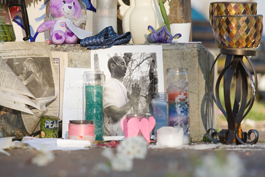home | north bay bohemian index | features | north bay | feature story

Photograph by Michael Amsler
Memorable: The shooting by officers of 16-year-old Jeremiah Chass has raised public protest. Citizens gather this week.
Zero Tolerance
What happens when citizens and officers take it the next step down.
By Richard J. Rapaport
Zero tolerance is the mind-set and rationale used these days to justify actions ranging from the expulsion of elementary school students for bringing alcohol-based mouthwash to school, to the sentencing of a mother to two years in prison for serving beer to her 16-year-old son and his classmates at a party.
Zero Tolerance has been invoked against a kaleidoscope of recent allegedly antisocial behaviors. Republican colleagues of Idaho senator Larry Craig clawed each other raw to declare zero tolerance for his alleged misdeeds in the men's room at Minneapolis-St. Paul International Airport.
Zero tolerance was on the faces of University of Florida police as they Tasered student Andrew Meyer during a speech by John Kerry. Meyer's imbecilic behavior, in fact, illustrated his own zero tolerance for the time and opinions of others.
Zero tolerance is in the American political bloodstream. It has become a featured player in the American judicial pageant. Its tenets justify draconian overcharging and Methuselah-like jail terms. It has helped transform American justice into an incarceration machine largely free from human interference or humane inference. Its justice absolves officials from accusations of weakness on crime, while jailing people in record numbers. According to a recent Justice Department report, the United States now has the world's largest prison population and highest rate of incarceration, with one in 32 American adults enmeshed in the criminal justice system. (For jail numbers in the North Bay, see Briefs, adjacent.)
The institutionalization of zero tolerance policies signals the triumph of a bureaucratic mind-set more obstinately retrograde than the once-derided French or German models. Have you been at the counter inside a Barnes & Noble, in line at movie theater or checking into a doctor's office and asked for a slight bending of the house rules? Not this time, chump.
Nor does it take a genius to explain why zero tolerance is transforming America into "the Land Mercy Forgot." Zero tolerance is, after all, the logical and syntactical equivalent of total intolerance. How unfortunate that there was no warning that we toiled under a system that has sanctioned total intolerance across the breadth of national life.
In zero tolerance America, God save the judge finding redemptive qualities in law-breakers. Discretion, once a tool of intelligent policing, has given way to drawn guns, takedowns and automatic arrest. Zero tolerance enforcement also sponsors a growing culture of entrapment that encourages the setups and stings that vacuum into the already bursting criminal justice system, not the truly dangerous, but often the merely stupid and weak, and, increasingly, those who simply don't have the mental health to decide otherwise.
Zero Patience
The years 1995 to 1998 were dark for Sonoma County citizens and law enforcement as some 15 people were either killed outright by officers or died in custody. The outrage almost a decade ago prompted the U.S. Commission on Civil Rights to recommend that a Civilian Review Board (CRB) be established to oversee local law enforcement independently. (Currently, the two arms—the Sonoma County Sheriff's Department and area police departments—oversee one another.) While many hailed the proposal for a CRB, it never came to pass.
Emotions and promises for action rose and fell away. Years passed, and then 2007 dawned darkly, with nine citizens dying so far this year either while interacting with officers or later while in custody. Area activists have no desire this time to let emotions and promises for action rise and slip away again, planning two upcoming events to move the community closer to greater transparency with and accountability by Sonoma County law enforcement. The killings by officers of Haki Thurston, Jeremiah Chass and Richard DeSantis between February and April of this year galvanized activists.
"Since the 'spate' of shootings in March, there's been no way for the community to come together," says west Sonoma County activist Mary Moore. "We need to strategize with the community, not just the elected officials." To that end, Moore—in conjunction with Free Mind Media's Ben Saari and other organizers—is bringing some 27 community groups together on Oct. 27 for a forum on police abuse that will look for ways to push to create a community-action plan.
Saari's energies are also engaged in organizing an Oct. 22 march in honor of the National Day of Protest aimed at stopping perceived police brutality. "[Law enforcement officials] think it's an isolated number of people who are upset," Saari says. "We need to make it clear that our community is currently saying, 'It's not OK for them to die.'"
March Against Police Brutality: Oct. 22 at 4pm. Meet at West Avenue and Sebastopol Road or Southwest Community Park, Hearn and Burbank avenues, Santa Rosa. 707.292.7642.
Public Forum on Police Abuse: Daylong forum aimed at conceiving a community action plan. Saturday, Oct. 27, at the Labor Center, 1706 Corby Ave., Santa Rosa. 10am to 5pm. Free. 707.953.3038.
Send a letter to the editor about this story.
|
|
|
|
|
|